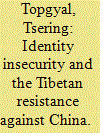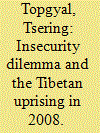| Srl | Item |
| 1 |
ID:
128531


|
|
|
|
|
| Publication |
2013.
|
| Summary/Abstract |
This article re-examines the five-decade-old Tibetan struggle against Chinese rule, asking what drives this multifaceted resistance. It argues that identity insecurity has been at the heart of the Tibetan struggle, and takes a position against the problematic practice in both the academic literature and popular discourse of treating Chinese policies and practices as security-driven and the Tibetan struggle as motivated by ethno-nationalistic impulses. It charts the vigorous contestation within the Tibetan diaspora between those standing issue images_86_3_Topgyal_Tibet_03for complete independence and others who are satisfied with "greater autonomy" and examines the multifaceted resistance inside Tibet. It also recognizes the unifying effects of the widespread loyalty to the Dalai Lama and fears for the survival of the Tibetan identity. The article also examines the links between Tibet and its diaspora. All these themes are developed while demonstrating the security rationale behind the Tibetan struggle
|
|
|
|
|
|
|
|
|
|
|
|
|
|
|
|
| 2 |
ID:
101926


|
|
|
|
|
| Publication |
2011.
|
| Summary/Abstract |
In March 2008, Tibet erupted in the biggest challenge to Chinese rule since 1959. While Beijing and Dharamsala engaged in their familiar battle of representations, pundits speculated on the causes of the uprising, ranging from conspiracy theories to informed policy analysis. Applying the framework of the insecurity dilemma, this article argues that Tibetan identity insecurity on account of the post-1989 hard-line Chinese policies was the chief cause of the uprising. Largely peaceful protests and occasionally violent riots in Tibet have been integral to Tibetan efforts to mitigate their societal insecurities provoked by Chinese migration, 'assimilationist' policies and 'cultural imperialism'. However, Tibetan protests and riots heighten Chinese insecurities and harden Beijing's policies both inside Tibet and towards the Dalai Lama. This paper reveals the dynamic cycle of hard-line Chinese policies provoking Tibetan uprisings; the resulting hardening in Chinese policies feeds back into Tibetan insecurities and protests. The 2008 uprising was the most recent cycle in the long-running saga of the Sino-Tibetan insecurity dilemma. The article warns that unless the Tibetans and the Chinese find a way to break out of the insecurity dilemma, Tibet could explode into another frenzy of violence and counter-violence in the near future.
|
|
|
|
|
|
|
|
|
|
|
|
|
|
|
|
| 3 |
ID:
148394


|
|
|
|
|
| Summary/Abstract |
This article argues that the Tibetan self-immolations constitute a form of counter-securitization to China’s securitization of the 2008 Tibetan uprising. Theoretically, it argues that securitization theory (1) is too focused on the intra-unit interaction between securitizing elites and audiences, (2) leaves the inter-unit dynamics underdeveloped, and (3) fails to recognize the securitized “other” as an audience. This article theorizes the linkage between unit-level and inter-unit processes by exploiting three concepts: inter-discursivity, identity, and emergency measures. Contrary to existing theories, it shows that even unsuccessful securitizing moves can set off counter-securitizations thanks to audience overlap and inter-discursivity. The Sino-Tibetan interactions around the Tibetan self-immolations uphold these theoretical positions.
|
|
|
|
|
|
|
|
|
|
|
|
|
|
|
|